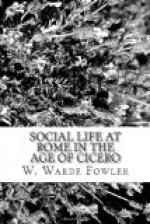Now making our way towards the Capitol, we pass the famous temple or rather gate of the double-headed Janus, standing at the entrance to the Forum from the Argiletum and the Porta Esquilina; then the Comitium and Curia (which last was burnt by the mob in 52 B.C., at the funeral of Clodius), and reach the foot of the Clivus Capitolinus, just where was (and is) the ancient underground prison, called Tullianum, from the old word for a spring (tullus), the scene of the deaths of Jugurtha and many noble captives, and of the Catilinarian conspirators on December 5, 63. Here the via Sacra turns, in front of the temple of Concordia, to ascend the Capitol. Behind this temple, extending farther under the slope, is the Tabularium, already mentioned, which is still much as it was then; and below us to the south is the temple of Saturnus, the treasury (aerarium) of the Roman people. Thus at this end of the Forum, under the Capitol, are the whole set of public offices, facing the ancient religious buildings around the Vesta temple at the other end.
The way now turns again to the right, and reaches the depression between the two summits of the Capitoline hill. Leaving the arx on the left, we reach by a long flight of steps the greatest of all Roman temples, placed on a long platform with solid substructures of Etruscan workmanship, part of which is still to be seen in the garden of the German Embassy. The temple of Jupiter Optimus Maximus, with his companions Juno and Minerva, was in a special sense the religious centre of the State and its dominion. Whatever view he might take of the gods and their cults, every Roman instinctively believed that this great Jupiter,




